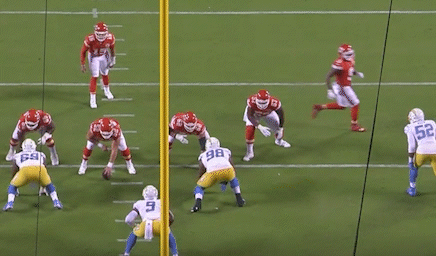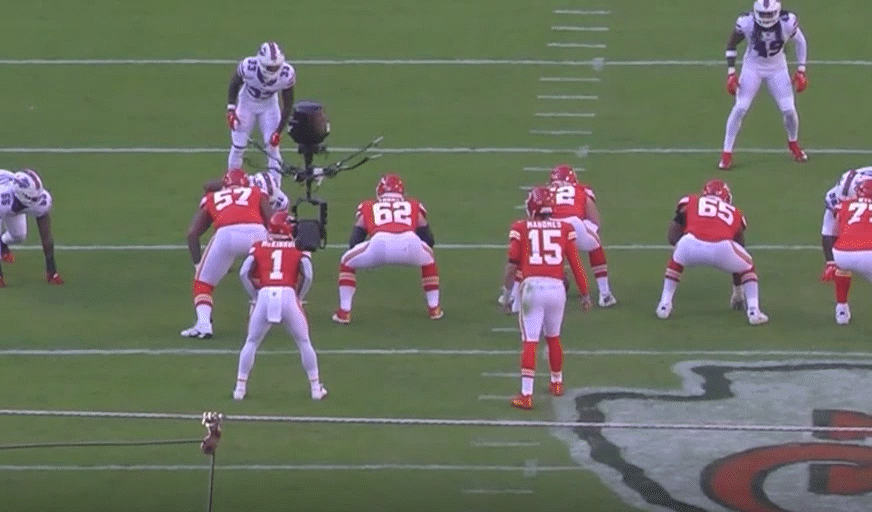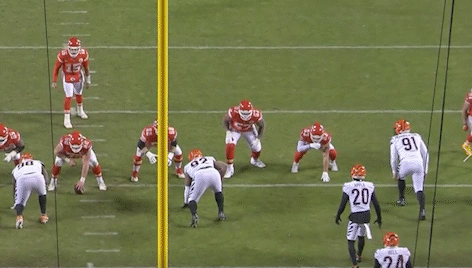Orlando Brown film review: What do the Chiefs do with their LT?
Looking at every pass-blocking rep in multiple games by the Chiefs' (soon to be former?) left tackle to get an idea as to where he and the team stand.
Things have escalated quite quickly with Orlando Brown Jr. and the Chiefs. As recently as Monday morning, it was assumed by most (myself included) that Brown would be given the franchise tag designation if he and the team were unable to come to a long-term agreement. And then…


There are a lot of potential takeaways from this. One could view it as Kansas City wanting to be more aggressive in free agency this year. One could view it as Kansas City being sure they’ll get a long-term deal done. One could view it as Brett Veach saying “we’ve given our best offer, go test the market.” It’s subject to interpretation and, from what I can tell, people are reading into it based on their already-formed opinions about Brown as a player.
When I wrote about what I would do if I were Brett Veach, I noted that I would likely only retain Brown for a bargain bin (relative to the market) price or perhaps utilize the tag. That was with the caveat of having reviewed some of his games but not fully charted them.
Now, this first step to that “let him walk” path by the Chiefs raises questions that need to be answered; Why would they be willing to go that route? Who is Brown as a player? And what is the path forward if they don’t retain him for the 2023 season?
To answer those questions, I find myself once again (as I did last season) looking to the film. How did Brown perform in 2022? How did it look relative to 2021, his first season as a Chief? And how might the answers to those two questions inform Brett Veach’s decision here?
So I went back and charted every pass protection snap by Brown in 7 games in 2022 (let’s face it, his work as a pass protector is FAR more important to the Chiefs than what he does as a run blocker) to answer those questions. I also wanted to determine what the team might believe about their ability to bring in a different LT and have similar levels of success (or at least not see a catastrophe unfold).
Let’s talk about what I found in those snaps, and where I land on the best path forward with Brown after diving more deeply into the film.
In case you’ve forgotten, the way I review/chart OL play is for wins, losses, and neutral plays, while also looking at (in cases of pass protection pressures/hits/sacks allowed. It’s a way to separate how the lineman performed from the rest of the offense and isolate how he played personally.
As a refresher, keep in mind that a 10% loss percentage is my line for what I’m comfortable with from a starter. There’s some variation game-by-game depending on quality of competition and amount of “help” a tackle gets (in the form of chips, moving pockets, rollouts, play action, slides, etc), but that 10% has served me well over the years. And losses are definitely the stat to watch the closest. The problem with a loss from an offensive lineman is that it can torpedo a play or, at the very least, make it much more difficult for the play to succeed. In other words, a win by a lineman doesn’t guarantee success, but a loss goes a long way towards guaranteeing failure.
Also, this won’t be quite as “in depth” in terms of who Brown is as a player as last year’s film review was. There’s a reason for that we’ll detail below, though I admit part of it is a time issue (but really, it’s because… well, I’ll get to that in second).
All right, here are Brown’s numbers in the games I charted. Remember, these are pass pro reps only.
There are a few things to take away from these numbers.
When comparing what we saw on film to what Brown did last season, you can see that his total loss percentage went up while his win percentage went down. Of course, part of that is that we’re not also looking at run blocking snaps, where he usually did pretty well. But it’s still less than ideal, though I’d note that his utterly disastrous outing against Cincinnati weighed heavily against him in the “total” numbers. It was one of only two performances in which he went above the 10% line, but it was SO high (thirty percent!) that it dragged his average way up there.
Of course, having disastrous performances isn’t something that’s supposed to happen to a high-end tackle, and that’s something to at least be thought about. Additionally, Brown crept entirely too close for comfort to that 10% line in 2 other games in addition to the one where Chargers game in which he went over it. Compare that to last year, in which he didn’t have a single game I reviewed over 10%, and that’s at least somewhat concerning.
I want to be clear, though, that some of this is just year-to-year noise (some). Overall, Brown is still the same player he was in 2021, with the same general strengths and weaknesses. This is why we’re not going to spend as long “who is Brown,” because it’s largely the same. He’s still a pretty capable tackle who provides above-average pass protection on average.
Brown’s combination of length, strength, and intelligence makes him very difficult for edge rushers to deal with, regardless of who they are. He has a significant size/length advantage over every opponent he faces and that allows him to consistently win at the initial contact OR forces opponents to take the long way to the quarterback every time. If he’s able to lay hands on a defender, the snap is generally over unless it ends up being a scramble drill or they end up in space alone. That ability to “freeze” even strong pass rushers is definitely a virtue.
And it’s also funny almost every time.
Brown’s smarts as a tackle are consistently underrated, as he’s a player who seems to have a good grasp as to his strengths and weaknesses. He’s smart with angles he takes and mixes up his sets a bit to keep opponents from keying in. He’s developed his vertical set a bit as a Chief (he’s had to, given their offense), which is a positive. He’s also developed good overall chemistry with Joe Thuney in handling stunts/twists up front from defensive linemen (though he struggled a early in the year), and usually anticipates when teams are trying to win that way.
Brown understands momentum and leverage, and generally utilizes it to his advantage. Because of his particular skillset (and again, this has been true since he was a Raven), Brown is able to turn most pass rushers into roughly the same guy, trying to win the edge over and over again.
However, there’s a good and a bad to that “he turns every rusher into the same guy” statement. While on one hand it can result in him performing at an above-average level against higher-end pass rushers (he gave Von Miller enough problems against Buffalo that they just started rushing Miller at Wylie consistently, where he had far more success), it also means that he’s prone to losing the same way against lower level pass rushers as he would against better players.
Brown generally attempts to push pass rushers wide over and over, and he’s generally quite successful in doing so. However, he loses that same edge at a higher rate than a high level tackle should because of his lack of agility. If a rusher with even moderate or poor bend is able to win the hands battle initially, they’re able to win around the corner because he can’t slide quickly enough to stay in front of them. This results in some ugly looking snaps against all sorts of opponents, but high quality and lower quality.
Because he’s not a natural mover laterally, Brown has to compensate by chasing a bit to send players wide. And that can, at times, lead to him having balance issues if he’s caught chasing and the defender has the agility to cut back inside and swipe away his hands. Here’s the very first pass protection snap of the season by Brown.
Obviously, that’s a less than ideal start to the year. Of course, to Brown’s credit he only had 3 more pass blocking losses the rest of the day, but this snap is demonstrative of the downside of Brown as a pass blocker; One never knows if THIS snap is the one where he’ll have a fairly quick, ugly loss. And that can result in some uncertainty for the quarterback if Brown is on an island.
Of course, again, we knew all of this already. Did anything really change from 2021 to 2022? Honestly, not much. Brown possessed the same strengths and weaknesses as the year prior overall. The one difference that I saw, and it was a relatively subtle one, is that Brown was a bit more prone to being beaten inside than he was last year, as defensive ends mixed up their tactics and tried to win the handfighting battle with him rather than going right through him. I also think, on the flip side, that he was slightly more agile down the stretch once he got healthy than he was in 2021, though he was still below average in that category.
After reviewing Brown’s snaps in-depth, I’m more appreciative of what he did in 2022 than I was to start off. As always, his film is better than his initial viewing, as his losses tend to stand out and feel more frequent than they are. He’s a good player, and he’s not going to be necessarily easy to replace. If the Chiefs chose to retain him on a very large contract I wouldn’t complain.
That said, I’m more hesitant than I was last year, and it’s partly about the “same guy as he was in 2021” issue. Following last year, the general thought was that as a young player in a new system, Brown’s needle was only pointing up in what he could do for the Chiefs. However, that development didn’t really occur in year two, and that makes his ceiling more questionable at this point. Yes, he’s a good player, but after another year without a step forward it’s hard to say he’ll become a “really” good player or a great one in Kansas City’s system.
Additionally, the Chiefs themselves (and this is solely guesswork on my part) seemed to figure that out as 2022 went along. To start the season they were still playing a bit more empty and giving Brown more 1x1 matchups on the outside. I don’t think it’s a coincidence that his loss percentage was consistently higher early in the season than it was down the stretch (though injuries certainly played a role too).
However, the horrifying Cincinnati outing in Week 13 felt like a bit of an inflection point. The Chiefs were already playing a lot more 12 and 13 personnel and lining up under center more, but they started sending more and more help Brown’s way as the season went along. This took various forms. You had the traditional chips from running backs, as well as putting tight ends on the line to help before moving into a route.
This was pretty frequent throughout the playoffs, especially once Mahomes hurt his ankle. The Chiefs spent a lot more time in heavier personnel, and while part of this was to mix things up a bit more in the run game and with play action (another way to help protect the tackles, by the way), it was also to provide both Brown and Wylie with help on the edges against good pass rushes.
It has to be noted that an offense pays a price for sending chips to help with pass protection. It slows down the routes of the players who are helping, and allows the defense extra time to clog passing lanes as they wait for the TE/RB to release and get into position. It also, during that same time, removes a viable “hot” target for the quarterback.
Of course, chips weren’t the only way Reid was helping both tackles down the stretch last year (and to be fair, he’s always helped them schematically, it was just more this year). The Chiefs ran more under center, they utilized more play action and moving pockets, they had more quick throws, and they threatened chips with their alignments in a way to slow down rushers as they thought about taking a hit. Their jet sweeps and screens played a big role as well, as did their slot receivers at times.
Action like this allows for pass protection to slide and for Brown to avoid a 1x1 matchup in space, and they utilized it with more frequency throughout the year.
In short, as the season went along, the Chiefs themselves did not behave as though they had a franchise left tackle. While Brown was trusted more than Wylie and was overall a good player, he was given assistance that one wouldn’t expect for an elite player, at least not with the sort of frequency he received it.
I say none of this to “dog” Brown as a player. He’s an above-average pass protector who has been a major part of the Chiefs’ success over the last two seasons. However, all of this does provide some clarity as to why the Chiefs may have elected to not tag Brown and drawn a line in the sand with what they’re willing to offer in a contract.
You can pay an above-average left tackle a big contract. A very big contract, even. But giving him a market-setting extension is much more difficult to do, especially when you need to adjust your offense around him at times the way you would to a less capable tackle. Do they need to do it as frequently as they would with an “average” player or with a rookie? Probably not. Did they, down the stretch in 2022, do it enough that the change may not be that large if they’re able to find a player who isn’t a weakness at the position? I think so, yes.
What players to give “top end” money to is a tough discussion. There’s a huge positional value factor, of course. But another good rule of thumb when thinking about whether to give a player elite money is to ask yourself this; Does this player allow us to make our playbook larger, or does he shrink it?
In other words, does the player’s ability give you additional schematic edges (like Mahomes/Kelce/Jones) because of the unique way they can win that opens things up for everyone else, or do you have to account for them in a way that forces you away from certain looks. With Brown, as capable as he is, the answer is certainly not the former and leans slightly more towards the latter. And the Chiefs, doing the same things they already did for him last year, should be able to bring a new player into the fold and protect him as he develops into their system (provided he’s at least an average player, which can be tough to find at LT).
Brown is a classic tough free agency decision; Good enough to miss, but not good enough to give top of market money. And after seeing how Reid adjusted for him down the stretch last year, I think the Chiefs likely agree. We’ll see how it plays out, but after looking at how they adjusted their offense in ‘22, it’s hard for me to not feel like a talented rookie couldn’t do nearly as well as Brown did last season under similar circumstances at a fraction of the price. Even if that means trading up, it could be a cost-controlling measure that pays off big as they look to shape up the rest of the roster and pay other offensive linemen long-term.












Wonderful article Seth, as always! Love the deep dive breakdowns on players. I wish you had time to do it for all 53 on the roster LOL.
This article, and the more I think about it, really leads me to believe they're going to draft an OT this year. It's pretty clear that the amount of help they had to give Brown would be better spent on a rookie learning the ropes, while hoping he can blossom into a star, rather than pay a premium for an above-average tackle who likely has hit his ceiling.
PS - that last gif with Toney 'chipping' (destroying?) the end with just his shoulder was HILARIOUS!
This pretty much sums up how I feel about Orlando Brown Junior. I don’t regret the trade, when they lost Eric Fisher and Mitchell Schwartz there was great uncertainty. Reminds me of when they drafted Mecole Hardman because of the things going on with Tyreek Hill. Sometimes in the face of uncertainty boldness is the best move. So I think the trade paid off (obviously, they are Super Bowl champions) but I am deathly afraid signing a good player to a huge contract would cripple them going forward. I tell you, I am more and more impressed with Brett Veach and his administration as every day goes by. Thanks for the review, Seth!